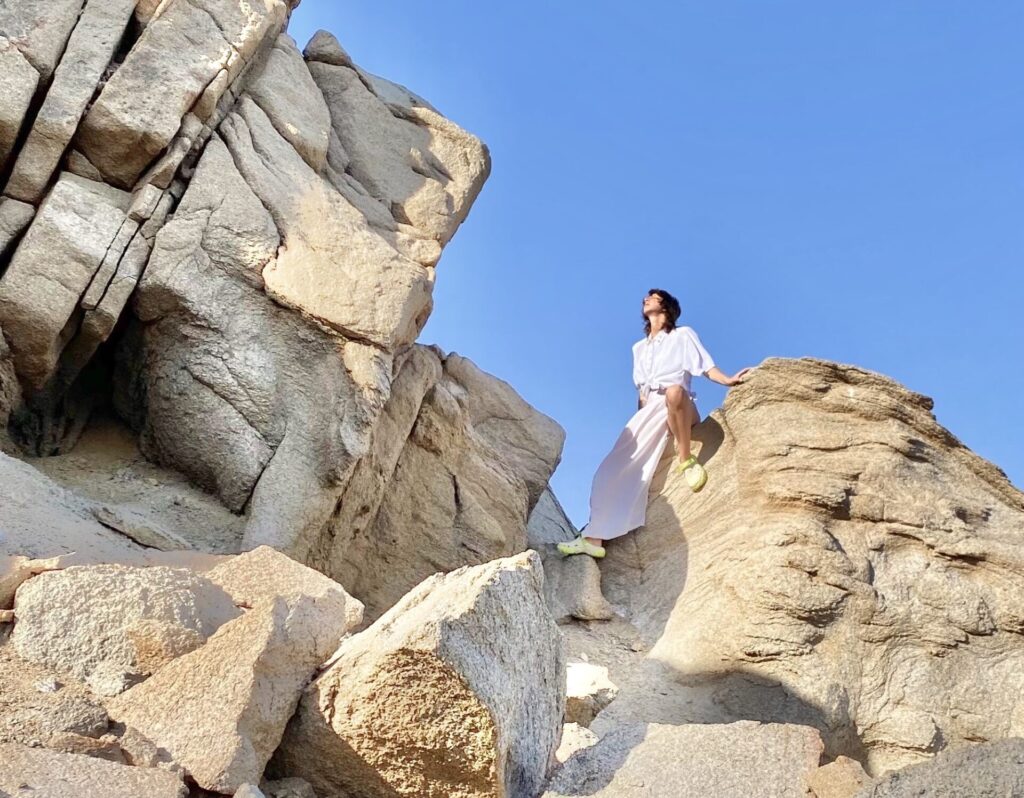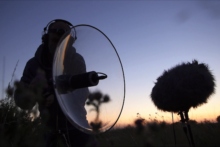I remember the first time I saw Antonina Nowacka. It was in The Kitchen at the Hotel Forum during the Unsound Festival, where she and her sister were playing as Mentos Gulgendo. They both played the Godwin electric piano, gradually, somewhat unevenly unfolding a draining musical suite, to which Antonina, at one point, joined in with her space-draining voice. I stood as if stunned – in the raw space of this brutalist building, I witnessed a minimalist musical mystery with a voice that mesmerised and seduced. I felt like Odysseus, whose siren song lures him to crash upon the rocks.
This element of resonating in space, of playing with air, was also present in their joint project, WIDT, and in several of Antonina Nowacka’s other solo works. Lamunan was based on vocal sketches created at Seplawan Cave in Indonesia and later recorded at Modlin Fortress near Warsaw. The Vocal Sketches from Oaxaca were recorded in small churches scattered throughout her journey in Mexico. On the other hand, Languoria, recorded with Sofie Birch, combined vocal elements with subtle but multi-layered electronics.
Nowacka did not graduate from music school but from the Academy of Fine Arts, which may set the scene for her perspective on creating music. She later studied Hindustani music in India with vocalist Shashwati Mandal. The combination of vocals with very particular equipment – much like at the concert I saw at the Hotel Forum – is present also in Sylphine Soporifera, an album on which Nowacka collects various instruments from different corners of the world, like an ocarina from Italy, bamboo flutes from Nepal or whistles from Mexico. On the other hand, betting on the uniqueness of the spaces she recorded, this time she’s stepping out of the cave into endless, bright spaces, as the album cover shows.
She ornaments her voice with a multilayered tapestry of sounds. On the one hand, the album has a strongly new-age flavour, which can already be heard in the opening track, ‘Moth Spins’, where an organ-based electronic mantra interweaves with the sound of a zither. ‘I Found You In The Cloud’ contrasts her vocals against a backdrop of resonating unison keys. There are afterimages of sound, patches of synth, and strokes on the zither, but the vocals unfold and weave here – a little fairytale-like, a little sacred.
Nowacka plays with sets: sometimes the electronics are closer, just behind her voice, sometimes the vocal is from afar as in ‘Nite Vision’, where flutes sound like they are far away and in the foreground there are patches of synths: reverberations, echolalia. ‘Odrracir’ serves vocals in the distance – when resonating synths come out, the vibration of the voice develops, space fills in, and a melody line emerges in the background.
That’s the play with air, intertwining with a voice from different distances and the roles of instruments. Sometimes, the delicate atmosphere reminds me of RVNG Intl artists or electro-acoustic manipulations by Ekkehard Ehlers or September Collective. But this new age 70s sound is still present, like in ‘Turning into Dolphins’, where she sings trembling vibrato vocals with increasing ambient touches, some cosmic music, resulting in mantric and impressionistic compositions. These are sound patches, signposts, interventions, making for an unhurried, dreamlike music.
Nowacka plays with air; she weaves her vocal phrases in an ethereal and mysterious manner, vibrating chants. On the one hand, her vocals are very down-to-earth, like a soothsayer allow through the desolate landscapes of Peru and the Outer Hebrides. On the other hand, she is like a transmitter of outer worlds of unspeakable vocals without words, conveying meditative metaphors dictated by endless spaces. This is the most vital element of her work: she chants melodies rather than sings. The content here is in the form. Nowacka is the instrument.
Although the instruments and place indicate roots in specific cultures and musical worlds, the Polish singer’s music seems borderless. She annexes them with her voice, creating a new context and instrumentally guiding delicate and sensual interventions. Air, resonating with sound, can take in a lot and is also her ally.
According to medieval legends, Sylphs were spirits or air beings full of delicacy, ethereality, and mystery. They were described as spiritual beings who develop human consciousness and guide in the transformation process, which can also lead a person down the path of madness. Nowacka plays and sings subtly, seductively, and soothingly, and her magnificent voice and music can lead to other states, somewhere between waking and sleeping.




